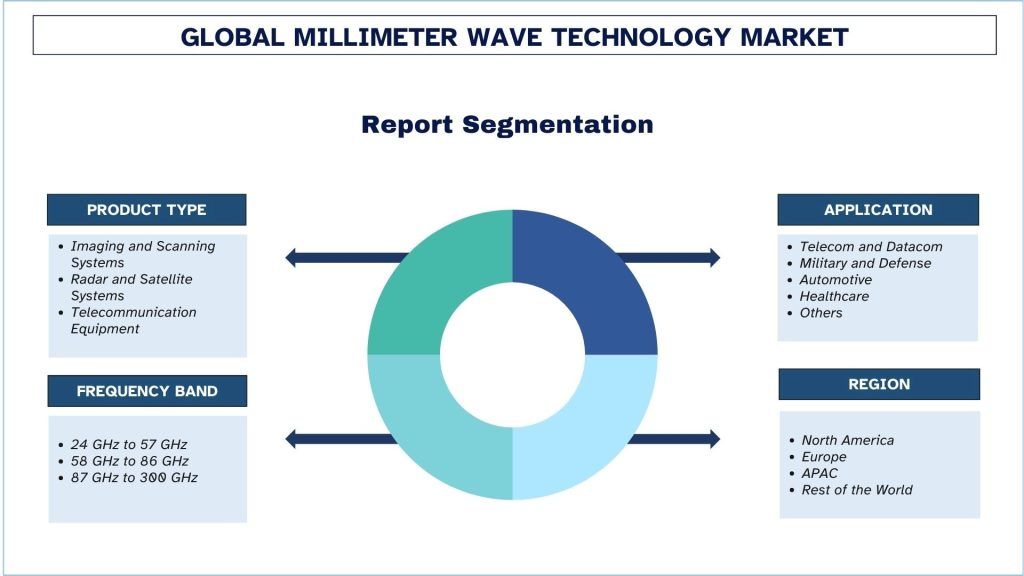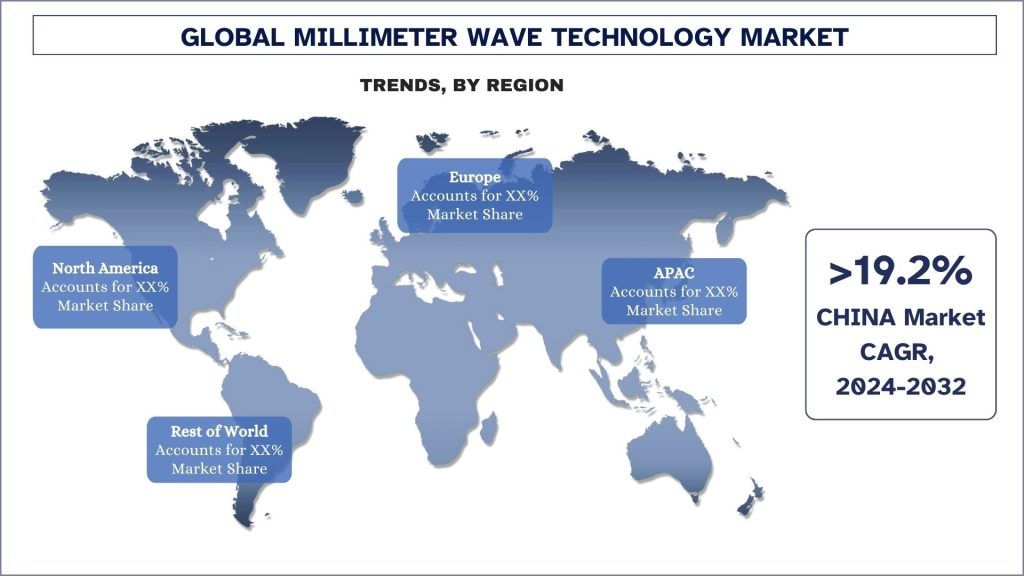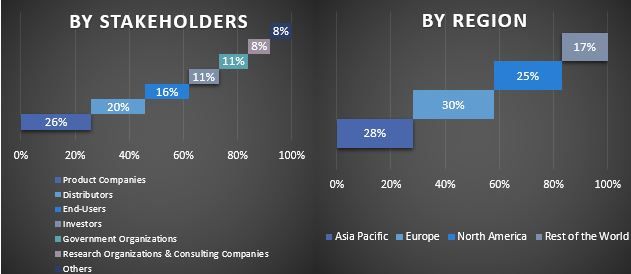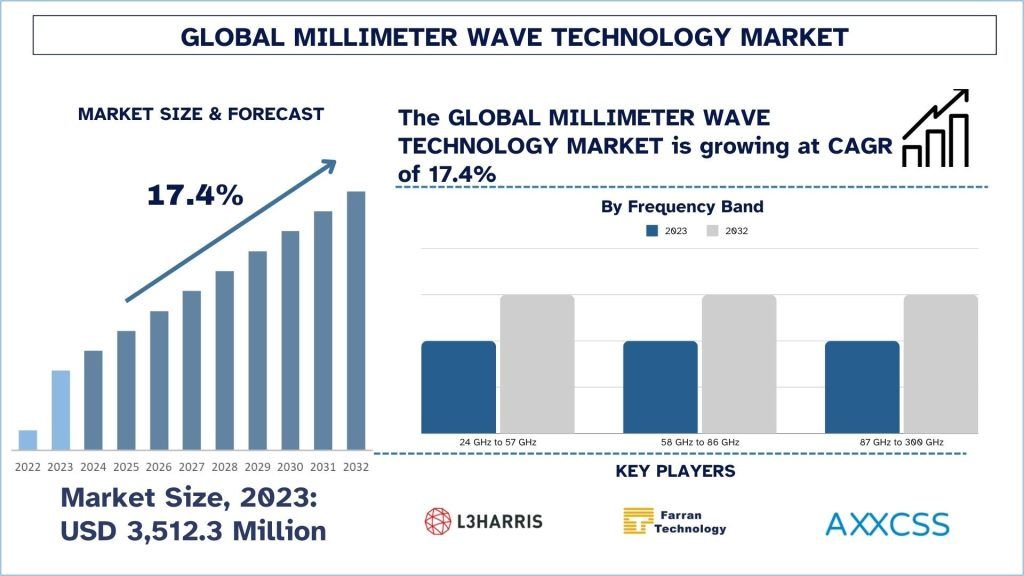- Home
- About Us
- Industry
- Services
- Reading
- Contact Us
Millimeter Wave Technology Market: Current Analysis and Forecast (2024-2032)
Emphasis on Product Type (Imaging and Scanning Systems, Radar and Satellite Systems, and Telecommunication Equipment); Application (Telecom and Datacom, Military and Defense, Automotive, Healthcare, and Others); Frequency Band (24 GHz to 57 GHz, 58 GHz to 86 GHz, and 87 GHz to 300 GHz); Region/Country.
Millimeter Wave Technology Size & Forecast
The Millimeter Wave Technology market was valued at USD 3,512.3 Million in 2023 and is expected to grow at a robust CAGR of around 17.4% during the forecast period (2024-2032) owing to the global expansion of 5G networks, which requires high-frequency millimeter wave bands to deliver ultra-fast data speeds and low-latency communication.
Millimeter Wave Technology Analysis
The Millimeter Wave Technology Market is evolving at a very high pace due to the UL demands for high bandwidths, low latency, and the development of 5G networks around the world. Millimeter wave technology uses the extremely high frequency (EHF) band with a range of 24GHz to 300GHz and therefore facilitates multi-gigabit data rates for use in telecommunication, defense, and automotive among others. Some of the factors include the 5G network deployment worldwide, increasing radar and satellite communication applications, and the increasing usage of connected devices which demand higher bandwidth and speed.
There has been tremendous investment in this market and mergers and acquisitions in the last couple of years have been quite frequent. For instance, L3 Technologies Inc. joined with Harris Corporation in 2019 yielding L3Harris Technologies which solidified its status in defense and aerospace uses of millimeter wave technology. Similarly, Siklu Communication Ltd has also expanded its portfolio and regularly growing through product releases like MultiHaul TG for wireless access at high speed. Telecom service providers’ investment in the infrastructure for 5G has been another factor, with North America and APAC at the forefront.
Future projections of the millimeter wave technology market include Asia-Pacific, and especially China and India, are, anticipated for the fastest growth due to the government’s effort towards the advancement of 5G. China’s aggressive plan to deploy 5G and India’s focus on the development of digital infrastructure are among the factors boosting market growth. Government policies and legislations being implemented in the two countries that have a positive impact on the growth of advanced telecommunications infrastructure are China’s 2060 carbon neutrality resolve and India’s Digital India initiative will create a large market for millimeter wave technology. These developments are on course to cement the place of millimeter wave technology across the different sectors in the Global arena.
Millimeter Wave Technology Trends
This section discusses the key market trends that are influencing the various segments of the Millimeter Wave Technology as identified by our team of research experts.
Government Policies Supporting the Millimeter Wave Technology Industry
The Millimeter Wave Technology Industry is heavily supported by a range of government policies, with data showing substantial investments and spectrum allocations worldwide to foster its growth. Below are data-driven insights on how government actions are advancing this sector:
5G Spectrum Allocations:
Specifically, it has been observed that for the development of the 5G network, governments across the globe have allocated a large part of the millimeter-wave spectrum. For example, FCC in the U. S has sold over 1,550 MHz of millimeter wave spectrum particularly in the 24 GHz and 28 GHz as a result of its accelerated 5G FAST Plan. Also, similarly, China assigned over 30 GHz of millimeter-wave spectrum to boost 5G advancement, which Japan and South Korea made spectrum release initial for 5G and made their way ahead in Millimeter-wave technology.
Telecom Development Programs:
India and China, for instance, are progressing with their broadband and telecom plan for the entire nation under programs such as BharatNet plan in India that targets to connect 250000 villages with broadband by 2025; and MM wave band. China intends to reach 56% population coverage by 5G by the end of 2025 with one-third of that deploying millimeter wave frequencies: all under the goal of reaching 1 billion 5G users.
Smart City Projects:
China’s 2060 Carbon Neutrality plan outlines the deployment of smart city uses of IoT, surveillance, and autonomous vehicles which operate in the millimeter wave bands. India’s Digital India Initiative has reserved ₹500 crore (about $ 67 million) to enhance the telecommunication sector the focus is on constructing a 5G network and smart city structures. These investments are important because they force urban regions to embrace better communication technologies as seen by the millimeter wave business.
Defense and Security Investments:
The U. S. Department of Defense has stepped up financing radar systems that employ millimeter wave technology for over $1. US $ 6 billion into the development of next generation surveillance and communication platforms. Other countries in Europe for instance France and Germany have also increased their defense budgets to accommodate research in the application of millimeter waves in military communications and satellite systems.

APAC is Expected to Grow with Significant CAGR During Forecast Period
The Millimeter Wave Technology Market of the Asia-Pacific (APAC) is growing fast due to the continuous roll-out of 5G networks and government support for improving the telecommunication sector. China, Japan, South Korea, and India are among such countries that invested significantly in the development of the 5G, smart city, and IoT projects. China in particular has been particularly assertive in the progression of 5G network build out using millimeter wave technology given the continued demand for high speed, low latency service.
Also, Japan and South Korea are the pioneers of the 5G network that uses Millimeter wave frequencies to improve the mobile connectivity and ensure the utilization of sophisticated developments like Smart Automobiles and Smart Cities. India is still beginning to implement 5G however the government program of Digital India will continue to develop the cultures of telecoms which will ultimately enhance the use of millimeter wave technology. In conclusion, the APAC region is expected to emerge as one of the most rapidly growing markets for millimeter wave technology, mainly because of increase in investments, emergence of novel technologies, and favorable government policies.

Millimeter Wave Technology Industry Overview
The Millimeter Wave Technology market is competitive and fragmented, with the presence of several global and international market players. The key players are adopting different growth strategies to enhance their market presence, such as partnerships, agreements, collaborations, new product launches, geographical expansions, and mergers and acquisitions. Some of the major players operating in the market are L3Harris Technologies, Inc., Farran Technology, Axxcss Wireless Solutions, Mitsubishi Electric Corporation, REMEC Broadband Wireless Networks LLC, NEC Corporation, Siklu Communication Ltd., Keysight Technologies Inc., Fujitsu, and Millimeter Wave Products Inc.
Millimeter Wave Technology News
August 2023 – Marki Microwave®, innovator in the radio frequency and microwave industry for over 30 years, acquired the waveguide business of Precision Millimeter Wave LLC, a leading supplier of sub-THz waveguide technology. The acquisition expands Marki Microwave’s reach into the evolving millimeter wave (mmWave) and sub-THz markets, enabling the company to create truly differentiated products that combine waveguide and traditional board-level connection methods.
Millimeter Wave Technology Report Coverage

Reasons to buy this report:
- The study includes market sizing and forecasting analysis validated by authenticated key industry experts.
- The report presents a quick review of overall industry performance at one glance.
- The report covers an in-depth analysis of prominent industry peers with a primary focus on key business financials, product portfolios, expansion strategies, and recent developments.
- Detailed examination of drivers, restraints, key trends, and opportunities prevailing in the industry.
- The study comprehensively covers the market across different segments.
- Deep dive regional level analysis of the industry.
Customization Options:
The global Millimeter Wave Technology can further be customized as per the requirement or any other market segment. Besides this, UMI understands that you may have your own business needs, hence feel free to contact us to get a report that completely suits your requirements.
Table of Content
Research Methodology for the Millimeter Wave Technology Analysis (2024-2032)
Analyzing the historical market, estimating the current market, and forecasting the future market of global Millimeter Wave Technology were the three major steps undertaken to create and explore the adoption of Millimeter Wave Technology in major regions globally. Exhaustive secondary research was conducted to collect the historical market numbers and estimate the current market size. Secondly, numerous findings and assumptions were taken into consideration to validate these insights. Moreover, exhaustive primary interviews were also conducted with industry experts across the value chain of the global Millimeter Wave Technology. Post assumption and validation of market numbers through primary interviews, we employed a top-down/bottom-up approach to forecasting the complete market size. Thereafter, market breakdown and data triangulation methods were adopted to estimate and analyze the market size of segments and sub-segments of the industry. Detailed methodology is explained below:
Analysis of Historical Market Size
Step 1: In-Depth Study of Secondary Sources:
Detail secondary study was conducted to obtain the historical market size of the Millimeter Wave Technology through company internal sources such as annual reports & financial statements, performance presentations, press releases, etc., and external sources including journals, news & articles, government publications, competitor publications, sector reports, third-party database, and other credible publications.
Step 2: Market Segmentation:
After obtaining the historical market size of Millimeter Wave Technology, we conducted a detailed secondary analysis to gather historical market insights and share for different segments and sub-segments for major regions. Major segments are included in the report such as Product Type, Application, and Frequency Band. Further country-level analyses were conducted to evaluate the overall adoption of testing models in that region.
Step 3: Factor Analysis:
After acquiring the historical market size of different segments and sub-segments, we conducted a detailed factor analysis to estimate the current market size of the Millimeter Wave Technology. Further, we conducted factor analysis using dependent and independent variables such as Product Type, Application, and Frequency Band of the Millimeter Wave Technology. A thorough analysis was conducted of demand and supply-side scenarios considering top partnerships, mergers and acquisitions, business expansion, and product launches in the Millimeter Wave Technology sector across the globe.
Current Market Size Estimate & Forecast
Current Market Sizing: Based on actionable insights from the above 3 steps, we arrived at the current market size, key players in the global Millimeter Wave Technology, and market shares of the segments. All the required percentage shares split, and market breakdowns were determined using the above-mentioned secondary approach and were verified through primary interviews.
Estimation & Forecasting: For market estimation and forecast, weights were assigned to different factors including drivers & trends, restraints, and opportunities available for the stakeholders. After analyzing these factors, relevant forecasting techniques i.e., the top-down/bottom-up approach were applied to arrive at the market forecast for 2032 for different segments and sub-segments across the major markets globally. The research methodology adopted to estimate the market size encompasses:
- The industry’s market size, in terms of revenue (USD) and the adoption rate of the Millimeter Wave Technology across the major markets domestically
- All percentage shares, splits, and breakdowns of market segments and sub-segments
- Key players in the global Millimeter Wave Technology in terms of products offered. Also, the growth strategies adopted by these players to compete in the fast-growing market
Market Size and Share Validation
Primary Research: In-depth interviews were conducted with the Key Opinion Leaders (KOLs) including Top Level Executives (CXO/VPs, Sales Head, Marketing Head, Operational Head, Regional Head, Country Head, etc.) across major regions. Primary research findings were then summarized, and statistical analysis was performed to prove the stated hypothesis. Inputs from primary research were consolidated with secondary findings, hence turning information into actionable insights.
Split of Primary Participants in Different Regions

Market Engineering
The data triangulation technique was employed to complete the overall market estimation and to arrive at precise statistical numbers for each segment and sub-segment of the global Millimeter Wave Technology. Data was split into several segments & sub-segments post studying various parameters and trends in the areas of Product Type, Application, and Frequency Band in the global Millimeter Wave Technology.
The main objective of the Global Millimeter Wave Technology Study
The current & future market trends of the global Millimeter Wave Technology were pinpointed in the study. Investors can gain strategic insights to base their discretion for investments on the qualitative and quantitative analysis performed in the study. Current and future market trends determined the overall attractiveness of the market at a regional level, providing a platform for the industrial participant to exploit the untapped market to benefit from a first-mover advantage. Other quantitative goals of the studies include:
- Analyze the current and forecast market size of the Millimeter Wave Technology in terms of value (USD). Also, analyze the current and forecast market size of different segments and sub-segments
- Segments in the study include areas of Product Type, Application, and Frequency Band
- Define and analysis of the regulatory framework for the Millimeter Wave Technology industry
- Analyze the value chain involved with the presence of various intermediaries, along with analyzing customer and competitor behaviors of the industry
- Analyze the current and forecast market size of the Millimeter Wave Technology for the major region
- Major countries of regions studied in the report include Asia Pacific, Europe, North America, and the Rest of the World
- Company profiles of the Millimeter Wave Technology and the growth strategies adopted by the market players to sustain in the fast-growing market
- Deep dive regional level analysis of the industry
Frequently Asked Questions FAQs
Q1: What is the current market size and growth potential of the Millimeter Wave Technology market?
Q2: What are the driving factors for the growth of the Millimeter Wave Technology market?
Q3: Which segment has the largest share in the Millimeter Wave Technology market by Product Type?
Q4: What are the emerging technologies and trends in the Millimeter Wave Technology market?
Q5: Which region will dominate in the Millimeter Wave Technology market?
Related Reports
Customers who bought this item also bought











